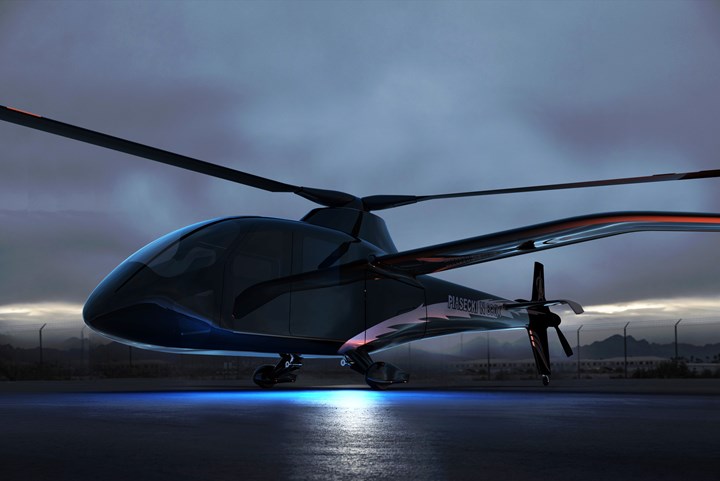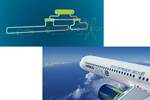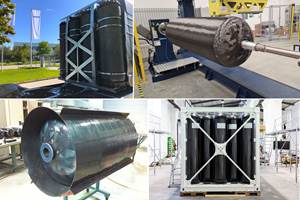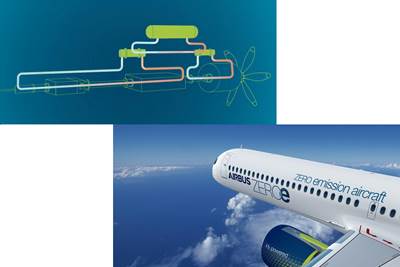HyPoint, Piasecki Aircraft collaborate to develop, certify eVTOL next-generation hydrogen fuel cells
Initial $6.5 million agreement to culminate in the development of five 650-kilowatt hydrogen fuel cell systems for use in Piasecki’s eVTOL PA-890 compound helicopter.
Share
Read Next

Rendering of the Piasecki PA-890 eVTOL compound helicopter, powered by the HyPoint turbo air-cooled hydrogen fuel cell system. Photo Credit: Piasecki Aircraft, HyPoint.
HyPoint (Menlo Park, Calif., U.S.), a company developing zero carbon-emission turbo air-cooled hydrogen fuel cell systems for aviation and urban air mobility (UAM), has entered into a multi-phase collaborative development agreement with advanced rotorcraft and unmanned aircraft systems (UAS) platforms and technologies company Piasecki Aircraft Corp. (PiAC, Essington, Penn., U.S.) for the development and certification of a hydrogen fuel cell system for electric vertical take-off and landing (eVTOL) vehicle applications. The initial $6.5 million agreement will culminate in the development of five 650-kilowatt hydrogen fuel cell systems for use in Piasecki’s eVTOL PA-890 compound helicopter, which the company says is expected to be the first manned hydrogen-powered helicopter.
The partnership’s objective is to deliver a customizable, FAA-certified, zero carbon-emission hydrogen fuel cell system to the global eVTOL marketplace. The system will reportedly offer eVTOL makers four times the energy density of existing lithium-ion batteries, twice the specific power of existing hydrogen fuel cell systems and up to a 50% reduction in direct operating costs relative to turbine-powered rotorcraft. Piasecki will gain exclusive license to the technology created as part of the partnership, and HyPoint will maintain ownership of its underlying hydrogen fuel cell technology. Piasecki and HyPoint intend to make the new system available to eVTOL makers by customizing it for use in their vehicles. Alternatively, eVTOL makers may choose to partner with HyPoint and Piasecki to develop a new system based on their specific needs.
“Our objective is to develop full-scale systems within two years to support on-aircraft certification testing in 2024 and fulfill existing customer orders for up to 325 units starting in 2025.”
HyPoint’s approach uses compressed air for both cooling and oxygen supply to deliver a hydrogen fuel cell system that is said to radically outperform existing battery and hydrogen fuel cell alternatives. Testing has shown that HyPoint's fuel cell system will be able to achieve up to 2,000 watts per kilogram of specific power, which is more than triple the power-to-weight ratio of traditional (liquid-cooled) hydrogen fuel cells systems. It will also boast up to 1,500 watt-hours per kilogram of energy density, enabling longer-distance journeys. In December 2020, HyPoint was named a winner of NASA's iTech Initiative, in which breakthrough technologies were ranked based on criteria that included technical viability, benefits to humanity and commercialization potential. HyPoint’s aviation applications — including eVTOL, UAS, personal air vehicles and electric aircraft — were considered to be especially innovative.
“The much-anticipated arrival of eVTOLs and similar aircraft has been severely hindered by the technical limitations of existing power systems,” says Dr. Alex Ivanenko, founder and CEO of HyPoint. “This new strategic partnership will dramatically accelerate delivery timelines by equipping eVTOL manufacturers with next-generation hydrogen fuel cell systems that meet their unique needs. Together, HyPoint and Piasecki will work to grow the emerging eVTOL market by delivering a certified multiplatform solution for eVTOL makers. In addition, we share a common vision for making safe, cost-effective zero carbon-emission flight a reality for conscientious businesses and consumers around the world.”
According to the partners, global eVTOL market size is forecasted to grow from an estimated $74 million in 2025 to $860 million by 2030, according to new market research. In the first few months of 2021 alone, $5 billion of investments were announced in the sector to Archer Aviation, Eve, Joby Aviation, Lilium and Vertical Aerospace. In January 2020, the Federal Aviation Administration (FAA) announced that it was engaged with manufacturers of more than 15 eVTOL aircraft. EHang, Volocopter, Joby Aviation and Lilium are among those that have signaled an intent to launch commercial passenger operations within the next three to five years. Other players include major aircraft companies such as Airbus and Boeing. The global hydrogen aircraft market is anticipated to grow from an estimated $27 billion in 2030 to $174 billion by 2040, according to Allied Market Research.
Piasecki is currently working with the FAA to outline certification criteria, as well as with the United States Air Force, by way of its AFWERX STTR/SBIR program, which is co-investing in the development of advanced hydrogen-powered aeronautical technology.
“We are laser-focused on the development and qualification of a 650-kilowatt system for our PA-890 eVTOL compound helicopter. Success will pave the way for collaboration with other eVTOL OEMs with different platform sizes to ensure broad application of this technology,” says John Piasecki, president and CEO of Piasecki. “Initial lab testing funded by Piasecki last winter demonstrated the technical viability of HyPoint’s hydrogen fuel cell system. While we are benchmarking HyPoint’s technology against alternatives and continue to rigorously test and validate findings, we are very optimistic. Our objective is to develop full-scale systems within two years to support on-aircraft certification testing in 2024 and fulfill existing customer orders for up to 325 units starting in 2025.”
Related Content
Lilium launches M&A process, targets eVTOL program continuation
Despite court-approved insolvency filings and beginning first investor briefings, Lilium remains fully focused on re-emerging following restructuring, setting its sights on fresh investment to support the Lilium Jet.
Read MoreParis Air Show 2023 highlights
The Paris Air Show, one of the largest aerospace trade shows in the world, returned for the first time since 2019 and proved that the global aviation industry industry is very much alive and kicking.
Read MoreComposites end markets: Pressure vessels (2024)
The market for pressure vessels used to store zero-emission fuels is rapidly growing, with ongoing developments and commercialization of Type 3, 4 and 5 tanks.
Read MorePlant tour: Joby Aviation, Marina, Calif., U.S.
As the advanced air mobility market begins to take shape, market leader Joby Aviation works to industrialize composites manufacturing for its first-generation, composites-intensive, all-electric air taxi.
Read MoreRead Next
Airbus ASCEND program to explore liquid hydrogen and superconductivity for zero-emission aircraft
Cryogenic hydrogen as cold source for lightweight, low-electrical loss powertrain, with composite materials as possible insulation.
Read More“Structured air” TPS safeguards composite structures
Powered by an 85% air/15% pure polyimide aerogel, Blueshift’s novel material system protects structures during transient thermal events from -200°C to beyond 2400°C for rockets, battery boxes and more.
Read MorePlant tour: Daher Shap’in TechCenter and composites production plant, Saint-Aignan-de-Grandlieu, France
Co-located R&D and production advance OOA thermosets, thermoplastics, welding, recycling and digital technologies for faster processing and certification of lighter, more sustainable composites.
Read More
























